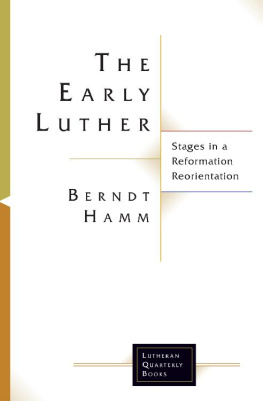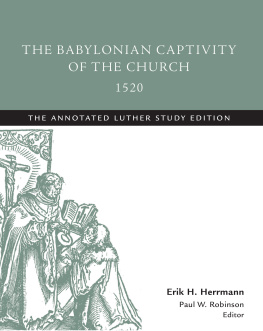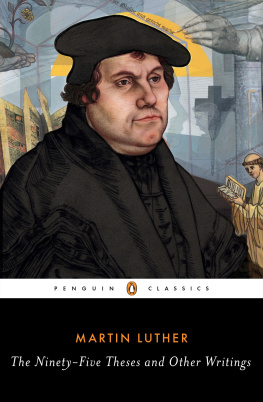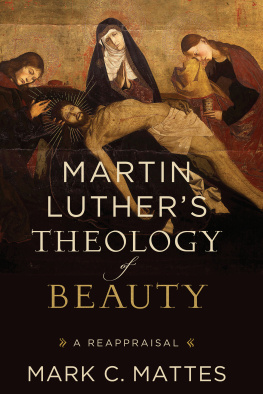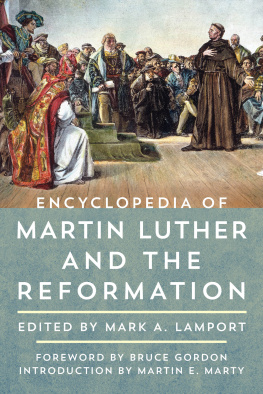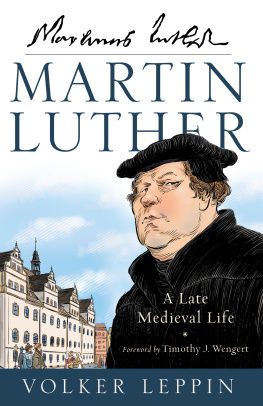LUTHERAN QUARTERLY BOOKS
Editor
Paul Rorem, Princeton Theological Seminary
Associate Editors
Timothy J. Wengert, The Lutheran Theological Seminary at Philadelphia
Steven Paulson, Luther Seminary, St. Paul
Mark C. Mattes, Grand View University, Des Moines, Iowa
Lutheran Quarterly Books will advance the same aims as Lutheran Quarterly itself, aims repeated by Theodore G. Tappert when he was editor fifty years ago and renewed by Oliver K. Olson when he revived the publication in 1987. The original four aims continue to grace the front matter and to guide the contents of every issue, and can now also indicate the goals of Lutheran Quarterly Books: to provide a forum (1) for the discussion of Christian faith and life on the basis of the Lutheran confessions; (2) for the application of the principles of the Lutheran church to the changing problems of religion and society; (3) for the fostering of world Lutheranism; and (4) for the promotion of understanding between Lutherans and other Christians.
For further information, see www.lutheranquarterly.com.
The symbol and motto of Lutheran Quarterly, VDMA for Verbum Domini Manet in Aeternum (1 Peter 1:25), was adopted as a motto by Luthers sovereign, Frederick the Wise, and his successors. The original Protestant princes walking out of the imperial Diet of Speyer 1529, unruly peasants following Thomas Muentzer, and from 1531 to 1547 the coins, medals, flags, and guns of the Smalcaldic League all bore the most famous Reformation slogan, the first Evangelical confession: the Word of the Lord remains forever.
Lutheran Quarterly Books
Living by Faith: Justification and Sanctification, by Oswald Bayer (2003).
Harvesting Martin Luthers Reflections on Theology, Ethics and the Church, essays from Lutheran Quarterly, edited by Timothy J. Wengert, with foreword by David C. Steinmetz (2004).
A More Radical Gospel: Essays on Eschatology, Authority, Atonement, and Ecumenism, by Gerhard O. Forde, edited by Mark Mattes and Steven Paulson (2004).
The Role of Justification in Contemporary Theology, by Mark C. Mattes (2004).
The Captivation of the Will: Luther vs. Erasmus on Freedom and Bondage, by Gerhard O. Forde (2005).
Bound Choice, Election, and Wittenberg Theological Method: From Martin Luther to the Formula of Concord, by Robert Kolb (2005).
A Formula for Parish Practice: Using the Formula of Concord in Congregations, by Timothy J. Wengert (2006).
Luthers Liturgical Music: Principles and Implications, by Robin A. Leaver (2006).
The Preached God: Proclamation in Word and Sacrament, by Gerhard O. Forde, edited by Mark C. Mattes and Steven D. Paulson (2007).
Theology the Lutheran Way, by Oswald Bayer (2007).
A Time for Confessing, by Robert W. Bertram (2008).
The Pastoral Luther: Essays on Martin Luthers Practical Theology, edited by Timothy J. Wengert (2009).
Preaching from Home: The Stories of Seven Lutheran Women Hymn Writers, by Gracia Grindal (2011).
The Early Luther: Stages in a Reformation Reorientation, by Berndt Hamm (2013).
The Life, Works, and Witness of Tsehay Tolessa and Gudina Tumsa, the Ethiopian Bonhoeffer, edited by Samuel Yonas Deressa and Sarah Hinlicky (2017).
Copyright 2017 Fortress Press. All rights reserved. Except for brief quotations in critical articles or reviews, no part of this book may be reproduced in any manner without prior written permission from the publisher. Email copyright@1517.media or write to Permissions, Fortress Press, PO Box 1209, Minneapolis, MN 55440-1209.
Interior contents have not been changed from prior English editions.
Foreword
When Matthias Pollicarius compiled and published the first set of biographical reflections on Martin Luthers life in 1547, already the early Luther played an important role, highlighted by material that recalled Luthers birth, his reception of the master of arts degree at the University of Erfurt, his struggle with Tetzel, and his appearance before the emperor in Worms.
The development of Luthers thought, with the twists and turns of his early biography, has commanded attention from scholars precisely because of the Reformation and its remarkable effects upon the history of Christianity in the West. Older scholarship, far from exhausting all avenues of research into the young Luther, has often become so enthralled by certain later debates that it has ignored many important sources of Luthers thought and has distorted the context in and against which that thought developed. In the present study, however, Berndt Hamm, armed with expertise in both late medieval intellectual life and Luther, develops new perspectives that leave old debates behind and shape a fresh look at some well-known sources. In so doing he builds creatively on the work of his teacher, Heiko Oberman, while providing new impulses for future research.
Perhaps the most important contribution of the essays in this book comes from Hamms ability to provide new insights into the development of Luthers theology from his entry into the monastery through his early lectures on the Bible to his writing of the Ninety-five Theses in 1517 and The Freedom of a Christian in 1520. Instead of looking for a single breakthrough, Hamm carefully outlines a series of important shifts in Luthers late medieval theological worldview that unfold over the length of his early career. In so doing, he gives credence both to early scholarship of the twentieth century, which insisted on an early date for Luthers breakthrough (before or in the midst of his first lectures on the Psalms in 1513-15), and to scholarship of the last half of the twentieth century, which often preferred a much later date (usually 1518) for the proper beginning of Luthers evangelical theology.
How Hamm argues is as important as what he concludes. Here his lifelong analysis of late medieval texts unlocks the finer nuances of Luthers comments. By fiercely insisting on placing Luther within his late medieval milieu, Hamm discovers how, slowly but surely, Luther leaves behind the medieval theology of love for the certainty of faith. Having set up this argument in the first chapter, in chapter 2 Hamm goes after one of the most beloved legends of Luther research: that Luthers early life in the monastery was only darkness and despair. Instead, Hamm insists that radical Anfechtungen (assaults, struggles, etc.) were a hallmark of Luthers developing evangelical theology, not a medieval remnant to be overcome. This result leads inexorably to Hamms third chapter, where he asks why faith became for Luther the central concept of the Christian life. Once again, the early biblical lectures loom large as an important source, showing just how the Reformation was, as Hamm puts it, an event embracing theology and piety. This combination begins to show up in Luthers insistence upon the hearing of faith, not the doing of works. As such, Hamm shows how the division between medieval continuity and Reformation breakthrough is a false distinction, where Luther is both medieval and evangelical at the same time.

